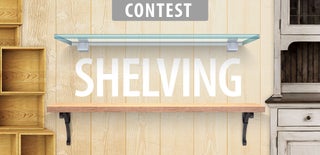Introduction: Collapsible Shelf
This is a collapsible shelf set with a very simple yet effective locking mechanism. It can be extended to use all three shelves if required. When not in use, the bottom two shelves can pushed back up, and two locking rods can be inserted, which saves some space and prevents dirt accumulation. It is very easy to construct and use.
Step 1: The Material Selection
Plywood for the shelves
Wooden bids on the front edges
Stainless steel rods for the locking mechanism
Stainless steel strips for nailing the shelf onto a wall
Wood Primer
Any enamel paint, we chose white
Step 2: The Tools – What You’ll Need to Bring It Together
A hand saw/table saw/reciprocating saw machine
A hand drill
Several nails (Size: 2d)
Fevicol
Masking tape
Brushes for painting
Step 3: The Dimensions
Thickness of plywood: 1 cm
Step 4: Cutting Out the Required Pieces
Cut out the following pieces:
Topmost shelf:
1 Base: 40x18
2 Walls: 18x14 each
Middle shelf:
1 Base: 45x18
2 Walls: 18x 15 each
Lowest shelf:
1 Base: 48x18
2 Walls: 18x16 each
Use a reciprocating table saw, or any other suitable wood cutting mechanism, to do this.
Step 5: Attaching the Walls
The walls should be attached at 1 cm from the edge of the shelf base.
Make markings on the middle and topmost shelf bases of where the walls are to be nailed in.
Apply fevicol to both the wood surfaces (The wall and the shelf base), join the walls and nail them in as shown in the figure.
For the lowest shelf, just place the walls on the edge and nail them in.
Step 6: The Locking Mechanism
We need symmetric holes in all three shelves, so that a rod may pass through it when all of the shelves are collapsed. Remember to make the hole a bit larger in diameter than the rods you have acquired for the locking mechanism.
Measure equal distances from the top of each shelf (Approximately 5 cm) and drill through each shelf one by one.
The rods themselves can be cut from old drafters like we did. All you need are two metal rods about 8 cm in length. Bend it from the top, so that it may be placed easily in the rod-holders (Explained below).
The rod-holders are just two loops screwed into the outermost shelf on each side, so that the rods may be placed on either side when not in use.
Step 7: Nailing in the Wall Hanger
Remember the two stainless steel strips? Just nail them to the back of the walls of the smallest shelf. If the strip is thick, cut out a bit of wood (equal to the thickness of the strip) from the back of the walls, so that the strip doesn’t cause a gap between the shelf and the wall where we’re going to hang it.
Step 8: Bidding
We thought we’d add something to make the shelf set look nice. Hence, we used strips of bidding on the front edges, as shown.
For the corners, we cut the bid diagonally.
Use sandpaper to sort out any rough, uneven surfaces and then apply fevicol to both the bidding and the edges. Nail the bidding in.
Step 9: Primer and Painting
You can either spray the shelves or use brushes to do the job. Do remember, though, to let the primer coat dry for at least a day before applying the paint.
Step 10: Mount It on the Wall!
And there you go. After the paint dries, either mount it on the wall or nail it in. Enjoy your shelf!

Participated in the
Shelving Contest 2016









